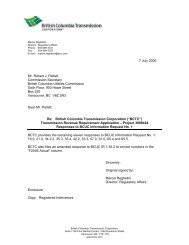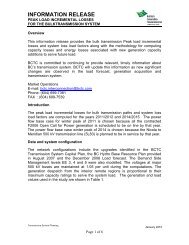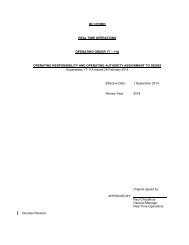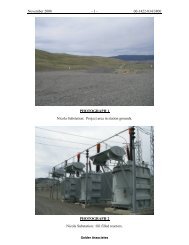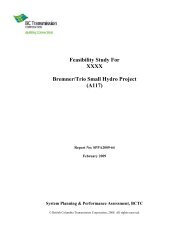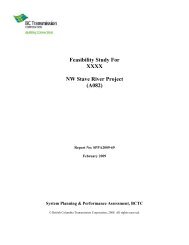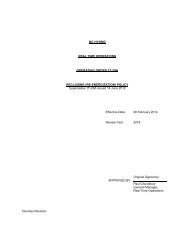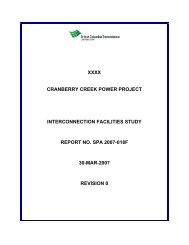Evidence on the Adequacy of First Nations Consultation - BC Hydro ...
Evidence on the Adequacy of First Nations Consultation - BC Hydro ...
Evidence on the Adequacy of First Nations Consultation - BC Hydro ...
Create successful ePaper yourself
Turn your PDF publications into a flip-book with our unique Google optimized e-Paper software.
DRAFT REPORT: Rights and Title Interests in <strong>the</strong> Columbia Valley Transmissi<strong>on</strong> Project Area<br />
Thomps<strong>on</strong>’s 1810-1811 journal describes his trip from Boggy Hill <strong>on</strong> <strong>the</strong> Saskatchewan River to<br />
<strong>the</strong> Athabaska Pass. 101 Once <strong>the</strong>y had arrived in late January 1811 at <strong>the</strong> mouth <strong>of</strong> <strong>the</strong> Canoe<br />
River in <strong>the</strong> Boat Encampment area, Thomps<strong>on</strong> and his men c<strong>on</strong>structed a cabin where <strong>the</strong>y <strong>the</strong>n<br />
spent <strong>the</strong> next two m<strong>on</strong>ths while building a canoe. In mid-April, with <strong>the</strong> new canoe now<br />
completed, Thomps<strong>on</strong> and his party set <strong>of</strong>f up <strong>the</strong> Columbia, travelling south. Deep snow and <strong>the</strong><br />
rapids <strong>of</strong> <strong>the</strong> upper Columbia made Thomps<strong>on</strong>’s trip difficult. He does not menti<strong>on</strong> in his journal<br />
seeing any Aboriginal people when he reached <strong>the</strong> Columbia River and began his ascent. Nor<br />
does Thomps<strong>on</strong>’s Narrative menti<strong>on</strong> <strong>the</strong> presence <strong>of</strong> Aboriginal people anywhere in <strong>the</strong> area<br />
between <strong>the</strong> Big Bend and <strong>the</strong> Columbia headwaters, apart from Cree and Iroquois Free Hunters<br />
met while Thomps<strong>on</strong> ascended <strong>the</strong> river. They were headed to <strong>the</strong> Canoe River, <strong>on</strong>e <strong>of</strong> <strong>the</strong>ir<br />
favourite locati<strong>on</strong>s to trap beaver. 102 In <strong>the</strong> vicinity <strong>of</strong> Canal Flat, <strong>on</strong> May 14 th , 1811, Thomps<strong>on</strong><br />
met two Ktunaxa who had just come from <strong>the</strong> Tobacco Plains, where <strong>the</strong>y had left most <strong>of</strong> <strong>the</strong><br />
Ktunaxa people. 103 Several days later, in <strong>the</strong> vicinity <strong>of</strong> what is now Jennings, M<strong>on</strong>tana,<br />
Thomps<strong>on</strong> and his men came across a “Tent <strong>of</strong> Kootanae Indians” who informed him that “<strong>the</strong><br />
great camp has moved from this place [Tobacco Plains] <strong>on</strong>ly three days ago,” 104 but that<br />
Thomps<strong>on</strong> would find <strong>the</strong>m, since he, too, was travelling to <strong>the</strong> “Saleesh” (Clark’s Fork River or<br />
Pend d’Oreille). 105 Thomps<strong>on</strong> and his men left <strong>the</strong>ir canoe around Jennings and proceeded<br />
overland by horseback. Not finding any<strong>on</strong>e at <strong>the</strong> Clark’s Fork River, Thomps<strong>on</strong> proceeded to<br />
Kettle Falls <strong>on</strong> <strong>the</strong> Columbia where he built ano<strong>the</strong>r wood canoe in order to descend <strong>the</strong> river to<br />
its mouth. 106<br />
Although Thomps<strong>on</strong> in <strong>the</strong> first few m<strong>on</strong>ths <strong>of</strong> 1811 passed through <strong>the</strong> entire upper Columbia<br />
Valley, from Boat Encampment to Canal Flats, <strong>the</strong> two Ktunaxa people he met in <strong>the</strong> Canal Flats<br />
area were <strong>the</strong> first local Aboriginal residents he reported seeing.<br />
Thomps<strong>on</strong> writes in his Narrative that, beginning in early July 1811, he proceeded down <strong>the</strong><br />
Columbia River to Astoria at its mouth, accompanied by seven company men, two Iroquois, and<br />
two Sanpoil translators. 107 His menti<strong>on</strong> <strong>of</strong> his company is notable, for <strong>the</strong> identity <strong>of</strong> <strong>the</strong> people<br />
101 Belyea 1994, page117.<br />
102 Glover 1962, pp. 328-329.<br />
103 Glover 1962, page 329, fn. 2.<br />
104 The Ktunaxa and freemen had left Tobacco Plains and were travelling south to <strong>the</strong> “Saleesh”<br />
[Fla<strong>the</strong>ad] country (Glover 1962, page 329, fn. 2).<br />
105 Glover 1962, page 329, fn. 2.<br />
106 Glover 1962, pp. 329-337.<br />
107 Glover 1962, page 339. The Sanpoil are speakers <strong>of</strong> <strong>the</strong> Okanagan-Colville (Interior Salish) language<br />
and live al<strong>on</strong>g <strong>the</strong> Sanpoil River in Washingt<strong>on</strong> State. The Sanpoil River empties into <strong>the</strong> Columbia about 90 Km<br />
downriver from Kettle Falls, Washingt<strong>on</strong>.<br />
Bouchard & Kennedy Research C<strong>on</strong>sultants Page 21<br />
Page 24 <strong>of</strong> 200






